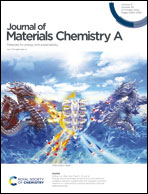Insights on the work function of the current collector surface in anode-free lithium metal batteries†
Abstract
Lithiophilicity has been a major factor in the design of current collectors for anode-free lithium metal batteries (LMBs). However, another design factor, work function, has not been considered in spite of its critical role in electron transfer at the current collector. Herein, we explore the role of the work function of the metallic current collector using two model Cu current collectors with different major surface facets of (111) and (310). According to DFT calculations, a higher index surface facet leads to a lower work function and a higher surface energy. Electrochemical analysis revealed that the Cu current collector with low work function favorably binds with Li, however, it is prone to decompose the liquid electrolyte and form a thick solid electrolyte interphase layer due to a lowered energy barrier for electron transfer. Although the two opposite effects vary depending on operating conditions, the irreversible capacity at the first cycle and the early capacity fade rate, which are the most critical issues for anode-free LMBs, are diminished by increasing the work function. This work provides a fresh perspective on the design of current collectors for advanced anode-free LMBs.



 Please wait while we load your content...
Please wait while we load your content...